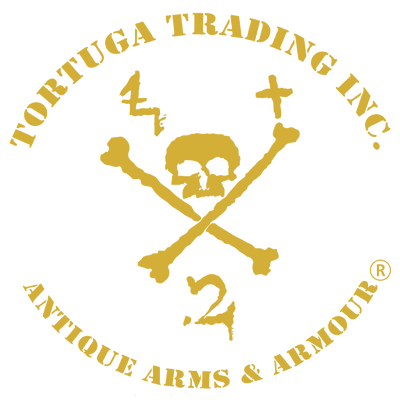A Very Rare American French & Indian War - American Revolutionary War British Long Land 1st Model Pattern 1742 Flintlock Private or Commercial Service Musket made by JORDAN, 1743
A Very Rare American French & Indian War - American Revolutionary War British Long Land 1st Model Pattern 1742 Flintlock Private or Commercial Service Musket made by contractor to the ordnance at the Tower of London, JORDAN and dated 1743. Full regulation length 46 1/8", .75 caliber bore iron barrel fitted with bayonet lug atop the muzzle and struck on the upper left section of breech with (2) London proof marks and the unidentified barrel makers mark in the middle. The distinct convex banana shaped lock has boarder line engraving with "IORDAN" (JORDAN) over the date of manufacture "1743", a large "CROWN" over "GR" (King George II 1727-1760) and the small "CROWN" over the "BROAD ARROW" (proof of Government ownership). The inside of the lock plate is stamped with the lock maker's mark of a small "CROWN" over "E I" (Edward or Edmond JORDAN), see photos. All brass regulation furniture includes the distinct "hazelnut" finial trigger guard with re-curve at the rear of bow, the (4) early style ram rod pipes made for the wood ram rod, heavy convex side-plate, the long finial butt plate, and a wrist escutcheon engraved with "19". All iron parts have light to moderate rust pitting (most on the barrel). Wood ram rod with correct brass tip. Original and correct iron sling swivels. The stock has all of the correct early contours and the brass nose cap or support band was never added to this example where later production in the late 1740's into the early 1750's were made with brass nose caps and iron ram rods. The pinned black walnut stock has a crack with an old possibly period repair running through the wrist (which is the most common place for a stress crack or break with these muskets), another stress crack just forward of the lower ram rod pipe but overall the stock is solid with scratches and dings from years of service and handling. 62.25" overall length. The musket is in it's original flintlock configuration. A rare musket in fine condition that would be very difficult to improve upon in today's market and in good mechanical working order.
NOTE: I have examined and studied these early muskets but owned only one other example of this model Brown Bess musket in 40 years ! The stock is absent of the usual military inspector(s) marks as well as the ordnance mark that should be on the comb of the stock on the right side of the butt. There are some assembly marks within the ramrod channel consisting of roman numerals. There are several possibilities for why these marking are not visible. The American forces that captured or procured weapons with British ownership markings were intentionally removed in fear of getting in trouble if caught. Or, this musket was not issued to the standard British infantry but instead made for a Militia Unit. Or, this is a very well done American Colonial re-stock made during the period of use. Regardless, this musket may have seen service in many of America's historical conflicts such as the French & Indian War (1754-1763) - American Revolutionary War, 1776-1783 !
ABOUT THE ADDITION OF A BRASS NOSE CAP - The British Army made changes in the design of the musket in 1740-1741 to the previous model 1730 Long Land musket. The trigger guard was re-designed, the raised decorative carving around the lock plate and side plate were omitted. The brass nose cap was added latter by regiments and then made as a standard in latter production. The brass nose cap was added to strengthen the wood from splitting and getting damaged.
ABOUT THE REPLACEMENT OF WOOD RAM RODS TO IRON - Simply, the wood ram rods wore out and broke over time from hard use on the battlefield. So, they were to be replaced by iron ram rods with "button" style tips when available. The brass ram rod pipes were modified with the one guide pipe having a pressure spoon added internally to retain the ram rod from falling out of the guide channel because the wood ram rod had a much larger diameter. The brass wood ram rod entry pipe would be replaced by a longer more slender variety (which became standard) in later production.
ABOUT THE MAKER - "IORDAN", (Edmond or Edward JORDAN) "J" in the 18th century was depicted as an "I". Others such as Clark, Farmer, Smith, Vaughan, Wood, Edge, Grice and The Tower of London produced muskets and pistols for the Ordnance.
Ref. see; Please see The Brown Bess: An Identification Guide and Illustrated Study of Britain's Most Famous Musket by Erik Goldstein and Stuart Mowbray, published 2010, pages 18 to 37, which confirm that "JORDAN" examples were supplied to the Ordnance and most were shipped to the American colonies.
Ref. see; Please see pp. 30-39, Small Arms of the British Forces in America 1664-1815, A Complete Guide to the Guns of the Red Coats ! by, De Witt Bailey, Ph. D., c. 2009.
Ref. see; Please see pp. 58,59, Battle Weapons of the American Revolution by, George C. Neuman., c. 1998.
TTI-596324
PRIVATE COLLECTION 2024






































